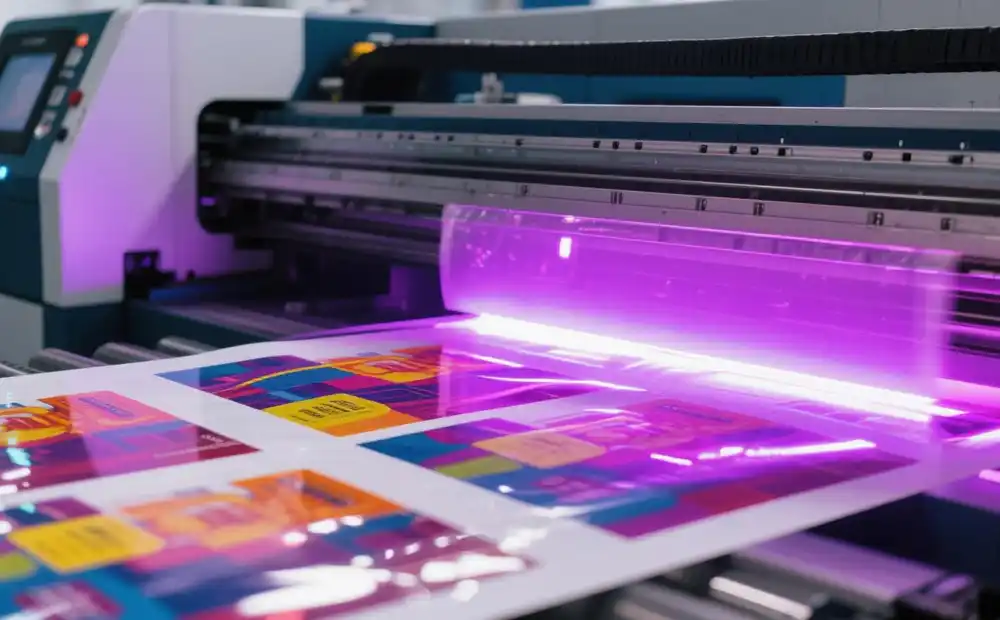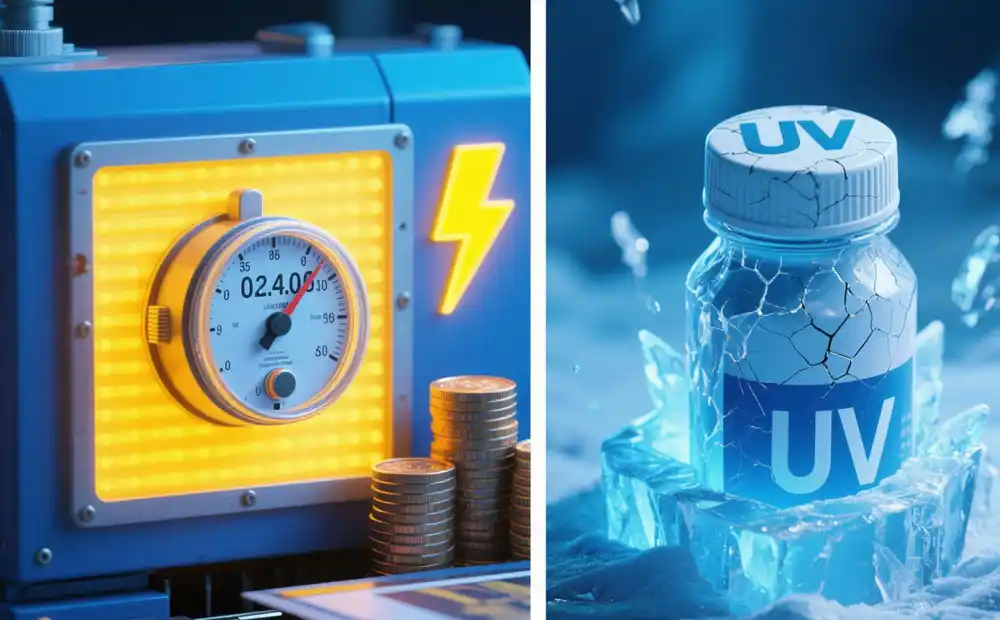 RU
RU
 EN
EN
 CN
CN

Position:HOME > Ink Knowledge > UV Ink
Date: Aug 29 2025 From: Star Color Views:
With the core advantages of “fast curing and low VOC emissions”, UV flexographic inks are gradually taking market share from traditional solvent-based inks. They are now widely used in food packaging, label printing, and decorative materials. However, due to their curing mechanism and formulation characteristics, they also face limitations in cost and substrate compatibility.
This article analyzes the advantages and disadvantages of UV flexographic inks from the perspectives of performance, production efficiency, and environmental safety, supported by real test data, to provide reference for printing companies in ink selection.
The strength of UV flexographic inks comes from “ultraviolet curing technology.” Unlike solvent-based inks that rely on solvent evaporation or water-based inks that depend on water evaporation, UV inks cure instantly when photoinitiators absorb UV energy and trigger resin polymerization (curing time ≤ 1 second). This feature provides multiple competitive benefits.
UV flexo inks do not rely on substrate absorption or ambient temperature and humidity. Under UV lamps, curing is nearly instant, solving the long-standing problem of slow drying and smudging with traditional inks.
In 600-line anilox roller and BOPP film printing scenarios, UV flexo inks can achieve speeds up to 400 m/min.
No need for long drying tunnels, reducing workshop floor space by 20%–30%.
During curing, UV flexo inks release virtually no solvents (VOC content ≤ 10 g/L), far below solvent-based inks (300–500 g/L) and water-based inks (≤50 g/L), and produce no wastewater discharge.
They easily comply with strict regulations, such as:
EU REACH (236 SVHC substances undetected)
FDA 21 CFR 175.300 (food contact compliance)
China GB 38507-2020 (VOC limits for inks)
This makes them particularly suitable for packaging in sensitive industries like food and pharmaceuticals.
After curing, UV inks form a highly crosslinked three-dimensional network, giving the ink film superior hardness, adhesion, and chemical resistance.
Hardness: 2H–3H; scratch resistance improved from 200 rub cycles to 600+ cycles.
Adhesion: On corona-treated BOPP film, cross-cut test reaches 5B, better than water-based inks.
Chemical resistance: No discoloration or swelling after 24h immersion in 10% acetic acid or 75% ethanol.
UV flexo inks work well on both absorbent and non-absorbent substrates without changing the formulation, reducing costs during job changes.
Compatible substrates: BOPP, PET, PE films, kraft paper, coated paper, aluminum foil, metallized films (adhesion up to 3B).
Printing results: High dot reproduction (150 LPI), high gloss, and color saturation superior to water-based inks.

Despite their strengths, UV flexographic inks also come with drawbacks, largely due to their curing requirements.
UV flexo requires dedicated equipment and consumables, making the initial investment much higher than traditional flexo, which is a barrier for small and medium-sized printers.
Equipment costs: A UV curing system costs about $21,000–$42,000 per unit.
Lamp lifespan: 800–1200 hours (3–6 months). Replacement lamps cost $70–$140 each, with annual consumable costs $2,800–$7,000 higher than traditional inks.
Ink costs: UV flexo inks are $8.40–$14/kg, double solvent inks ($4.20–$7/kg) and 1.5× water-based inks ($5.60–$8.40/kg). Specialized cleaning solvents add another $11–$17/kg.
Overall cost estimation: For a production line of 10 million m²/year, initial investment is 40%–60% higher than water-based flexo, with annual consumable costs 15%–20% higher. ROI typically takes 2–3 years through efficiency gains.
UV flexo relies entirely on UV curing, which consumes more energy and poses safety risks.
Energy consumption: UV lamps run at 80–120W/cm. An 8-color UV flexo press requires about 100–150kW, 3× higher than hot-air drying, increasing electricity costs by $7,000–$14,000 annually.
Safety risks: UVC radiation (200–280nm) from UV lamps can damage skin and eyes, requiring shielding and protective gear. Small amounts of ozone generated during curing can irritate the respiratory system, requiring ozone treatment systems.

The pros and cons of UV flexo inks mean they are not ideal for all applications. Here is a guideline:
| Scenario | Core Requirement | UV Flexo Recommended? | Reason |
|---|---|---|---|
| Food/Pharma Packaging | Safety, low migration | Yes | Meets FDA & GB standards, solvent-free, fast curing prevents microbial risks |
| Outdoor/Weather-Resistant Labels | Scratch & UV resistance | Yes | Strong hardness and weathering, shelf life 2–3 years |
| High-Speed Label Printing (>300 m/min) | Efficiency, low defects | Yes | Instant curing, 50% faster than water-based inks |
| Frozen Food Packaging (<-10℃) | Flexibility, low-temp resistance | No | Becomes brittle at low temps; water-based inks with antifreeze are better |
| Small Batch/Custom Printing | Cost-sensitive, frequent job changes | No | High investment, higher cleaning cost, no cost advantage |
| Thick Paper/Cartonboard | Low cost, absorption control | No | High ink cost, poor curing on thick absorbent substrates |
UV flexographic inks offer “fast curing, eco-friendliness, and superior performance,” making them a top choice for premium packaging applications. However, “high costs and high energy use” remain barriers to universal adoption.
Printers should evaluate ink choice based on production scale, product positioning, and cost tolerance. In some cases, a “hybrid process” (UV for highlights + traditional inks for base printing) may help maximize benefits while minimizing drawbacks.